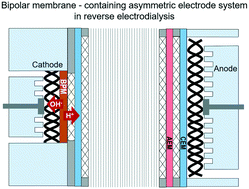Asymmetrical electrode system for stable operation of a large-scale reverse electrodialysis (RED) system†
Abstract
In a large-scale reverse electrodialysis (RED) system comprising several hundreds of cell pairs, the contribution of electrode resistance to total resistance is very small compared to that in typical electrochemical cells (e.g., fuel cell and battery). This feature indicates the low susceptibility to both electrocatalytic ability of the electrode and solution conductivity, and to the geometrical area of the electrode as well. Therefore, in this work, we introduce an asymmetrical electrode system, where the geometrical area of the cathode is smaller than that of the anode. Since the cathode is highly vulnerable to significant inorganic scaling due to the high pH conditions during water reduction and crossover of multivalent ions in the natural feed solution, it is expected that minimizing the contact area between the electrode and feed solution by reducing the geometrical area of the cathode can afford more stable electrode reaction and electric power during long-term operation of RED. We measured the changes in electric power as a function of various areas of the cathode in lab- (100 cell pairs) and large-scale (1000 cell pairs) RED systems, which confirmed that even though the cathode area corresponds to 60% of the individual area of the ion-exchange membrane (IEM), the maximum power was obtained with only 3% power loss. In addition, the surface properties and permselectivity of a shielding membrane at the cathode were analyzed by X-ray photoelectron spectroscopy (XPS) and membrane potential measurement to verify the stability of the IEM under higher current density. We recommend the use of the asymmetric electrode system with a bipolar membrane (BPM) to suppress inorganic scaling around the cathode. The high current density achieved by reducing the size of the cathode can induce vigorous water splitting in the BPM, which leads to more effective blocking crossover of the multivalent and hydroxide ions. It can hence be used to design a highly stable electrode system for the long-term operation of a pilot-scale RED system fed with natural feed solutions.



 Please wait while we load your content...
Please wait while we load your content...